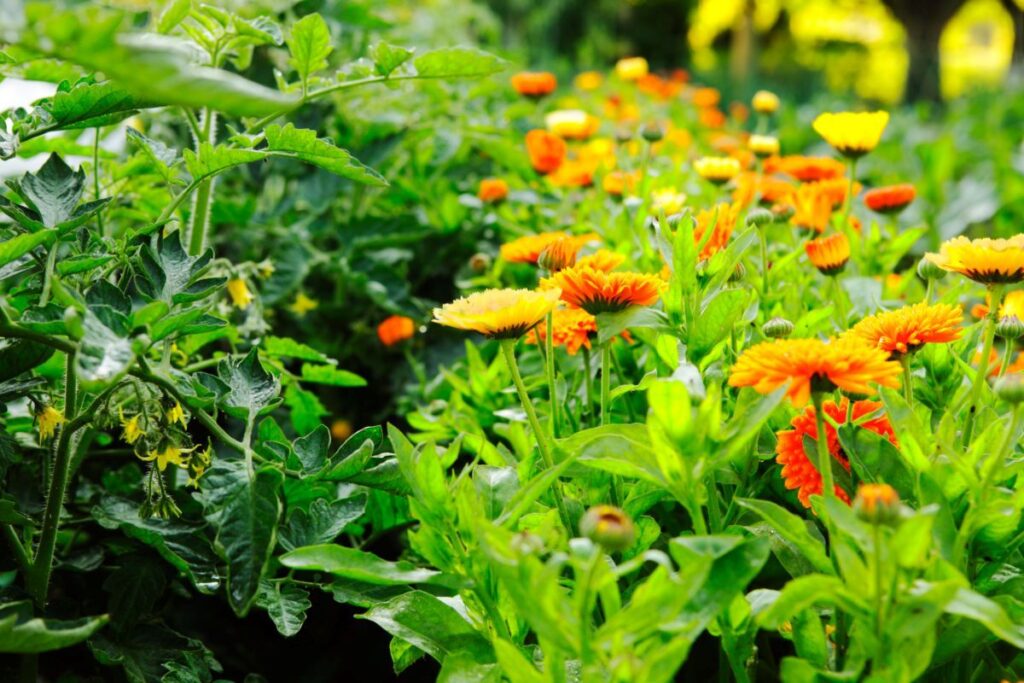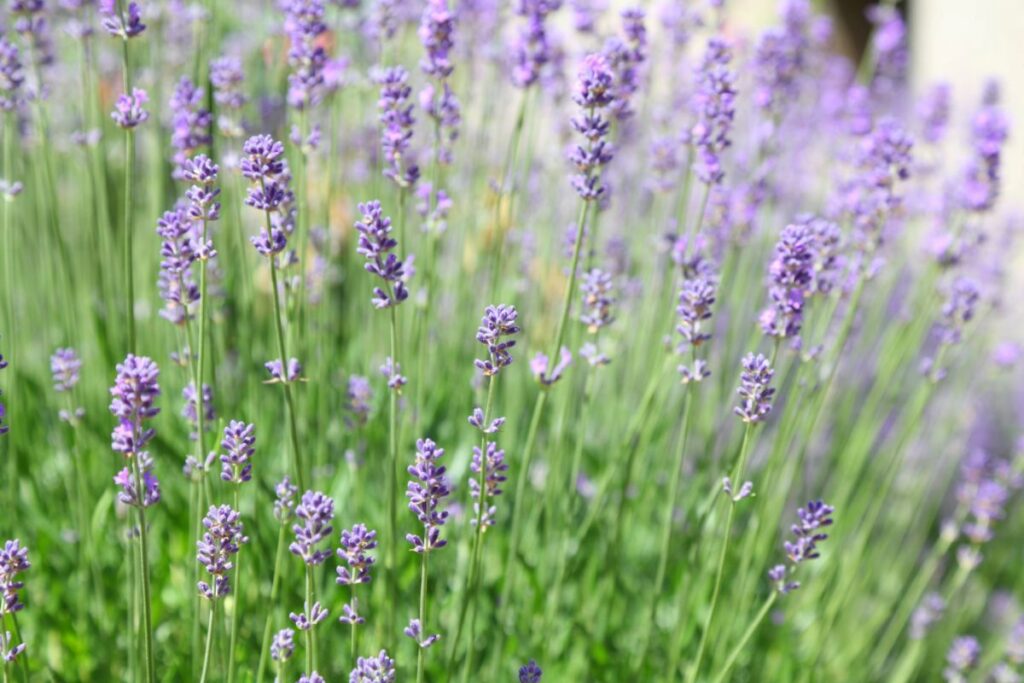Calendula is one of my all-time faves to use as a companion to so many types of flowers and plants!
These pretty, vibrant-colored flowers don’t only make your garden look great, but they also protect nearby plants from pests and even attract pollinators.
I’ve been growing calendula for donkey’s years, and in that time I’ve found the very best companion plants include:
- Carrots
- Potatoes
- Corn
- Strawberries
- Cucumber
- Roses
- Lavender
- Geranium
- Salvia
In this post, I’ll take a look at all of these, and throw in a load of top tips of the trade for getting your calendula and surrounding plants looking in perfect shape!

5 Fruits and Vegetables That Grow Well With Calendula
Calendula plants can be awesome additions to your vegetable garden for a host of reasons.
First off, their somewhat strong smell efficiently masks the delicious scent of nearby crops, which helps ward off rabbits and rodents.
Second of all, Calendula flowers release chemicals into the soil that keep damaging nematodes and microorganisms at bay.
Plus, the color of these lovely blooms is eye-catching for butterflies and bees. The frequent visits of these pollinators contribute to the reproduction of companion plants.
Now that you understand the benefits of growing Calendula with vegetables and fruits, let’s take a look at the best candidates to pair it with in your garden!
1. Carrots
Carrots and Calendula plants can be wonderful partners in a vegetable bed, as carrots will greatly benefit from Calendula’s pest-deterrent nature.
The Calendula helps repel aphids and flea beetles—two of the carrot’s most annoying parasites.
Just remember that you need to space these two plants a foot apart because Calendula flowers tend to grow into big, bushy blooms. You don’t want them to crowd the carrots!
2. Potatoes
Next, you’ve got potatoes as companion plants for the Calendula. What makes them a successful pairing is that they both thrive in the full sun, not to mention that the Calendula aids in the protection of potato leaves by deterring rabbits and potato beetles.
Plus, Calendula plants release compounds into the ground that ward off root-knot nematodes. This minimizes the chances of your potato crop coming out with blemishes.

3. Corn
Corn stalks tend to suffer from corn leaf aphids, which are the main concern of many gardeners when growing corn in their yards.
That’s why you can reduce or completely ditch the use of pesticides by planting Calendula with your corn crop.
4. Strawberries
Besides complementing each other’s looks when in full bloom, Calendula plants and strawberries are fantastic companion plants because of how they draw pollinators.
See, Calendula plants attract beneficial insects like bees and hoverflies that help pollinate strawberries. Even better, these tiny creatures often feed on pests that both plants are susceptible to, such as:
- Slugs
- Thrips
- Spider mites
5. Cucumbers
Growing cucumbers is surely refreshing in the overpowering heat of summer, but these vegetables are always at risk of attacks by insects and animals like rabbits. They’re also prone to infestations led by:
- Squash beetles
- Flea beetles
- Aphids
- Cucumber beetles
That’s why we suggest you pair them with Calendula plants to provide a good degree of protection from hungry pests.
Remember that cucumber is best planted on trellises or along fences because it takes up a lot of space.
Because Calendula flowers grow quite large, too, try to interplant them next to the trellis or on the border of your vegetable garden to leave enough room for all the plants involved!
4 Flowers That Grow Well With Calendula
Besides having matching growing requirements like sunlight exposure and temperature, the following flowers are great Calendula companions because of how they complement each other’s appearance!
1. Roses
Whether you go for white, red, or pink, combining different-colored roses with your Calendula flowers will surely result in a beautiful flower garden with many eye-catching pops of color.
Better still, some rose varieties are multi-color or two-toned, further increasing the aesthetic appeal of your yard alongside lovely Calendula flowers.
If you’re unsure which rose types to mix into your Calendula collection, here are our favorites along with their hardiness zones, light needs, and size:
| Rose variety | Hardiness zone | Sun exposure | Mature size |
| Cherry Parfait | 6 to 11 | Full sun | 3 to 4 feet |
| Mardi Gras (Rosa floribunda) | 5 to 9 | Full sun | 3 to 4 feet |
| About Face (Rosa grandiflora) | 6 to 11 | Full sun | 5 to 6 feet |
| Falstaff (Rosa falstaff) | 5 to 11 | Full sun | 4 feet |
| Bonica (Rosa bonica) | 4 to 11 | Full sun | 3 to 5 feet |
2. Lavender
You can’t say no to the soft yet proud appearance of lavender flowers, especially since it perfectly contrasts with the Calendula’s bright, daring attire.
Better still, both flowers are tall, creating an effective insect barrier that can contribute to the protection of any vegetables or fruits you interplant with them like tomatoes.
Finally, consider blending lavender into your Calendula collection because the former thrives in almost all soil types. Plus, both plants are pretty low-maintenance!

3. Geranium
Geraniums also pair well with Calendula flowers thanks to their pink and purple blooms, giving your garden a colorful appeal that will definitely draw the eye!
Yet, we like these two flowers together even more because the Calendula helps repel the slugs that often feed on Geraniums. Plus, both flowers like the full sun and aren’t hard to grow, making them perfect for beginner gardeners.
In addition, they’re both useful in protecting other crops, like potatoes, tomatoes, and carrots from annoying parasites.
4. Salvia
If you want to add a desirable contrast in height to your flower garden, consider planting Salvia flowers toward the back and Calendula blooms at the front. The former stands tall at two feet with pretty violet blooms that are similar to those of lavenders.
What also makes these two flowers suitable partners is their love for the sun, pollinator attraction abilities, and all-season bloom!

